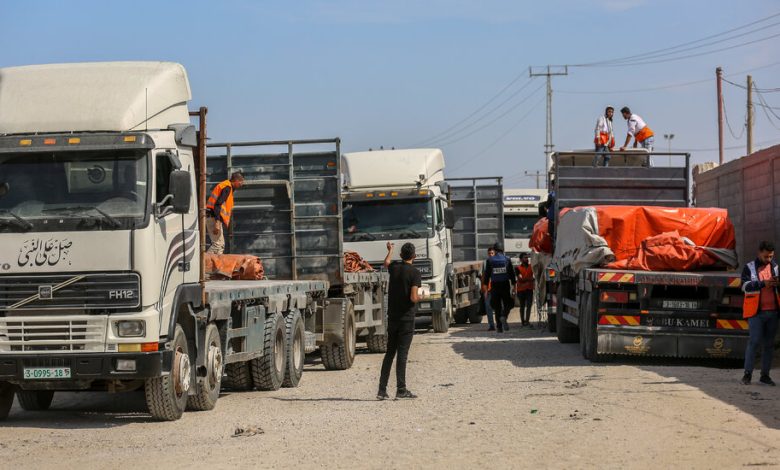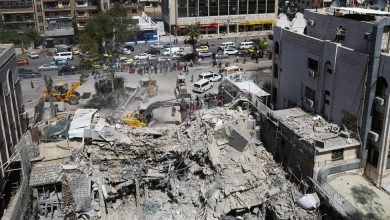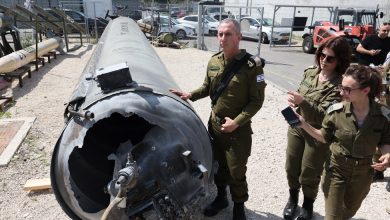First Humanitarian Aid Reaches a Hard-Pressed Gaza

After days of diplomatic wrangling, 20 trucks carrying food, water and medical supplies crossed into Gaza on Saturday, providing a ray of hope for the more than two million residents of the enclave, whose living conditions the United Nations called “catastrophic.”
The first of what U.N. officials described as a trickle of aid, a respite in Israel’s blanket siege of the enclave imposed after the Hamas terrorist attacks of Oct. 7, came after intense negotiations, including during President Biden’s visit to Israel last week.
But the deal allowed the passage of only a fraction of the long line of trucks waiting to carry 3,000 tons of aid from Egypt into Gaza. Negotiations for future shipments were continuing, and it was unclear when more aid would be allowed in.
“The supplies currently heading into Gaza will barely begin to address the escalating health needs as hostilities continue to grow,” the World Health Organization, which supplied trauma kits as part of the convoy, said in a statement on Saturday. “Much more is needed.”
The shipment was delayed for days out of Israeli concerns that it might be used to funnel weapons and munitions to Hamas. It did not include the fuel that the United Nations says isneeded to run medical facilities and water desalination plants. The Israeli military is blocking fuel from the territory because it fears it will be used by Hamas for military purposes.
Seven hospitals and 25 health care clinics are out of service because they ran out of fuel, according to the Gaza Health Ministry, operated by Hamas.
Saturday marked two weeks since the Hamas rampage that killed more than 1,400 Israelis and triggered Israel’s declaration of war. Two of the more than 200 hostages believed to have been seized by Hamas during the terror attack, Judith Raanan and her teenage daughter, Natalie, were released Friday. Negotiations are continuing among several countries and Hamas representatives in Qatar about the other hostages, but there is no indication of when they might be released or how they are faring in captivity.
The exact number of hostages and their fates remain uncertain. “The majority of the hostages are alive,” the Israeli military said Friday in a statement that provided cold comfort to the families. The military said that more than 20 of the hostages are under 18 and at least 10 are over 60.
With tanks, armored personnel carriers and militarized bulldozers massed near the northern Gaza border in preparation for what Israel has said will be a ground invasion to wipe out the top leadership of Hamas, residents of the enclave waited anxiously on Saturday for full-scale war. The Israeli military has outlined plans of an invasion of Gaza that would include tens of thousands of soldiers ordered to capture Gaza City, in the northern part of the territory.
Israel’s military spokesman, Rear Adm. Daniel Hagari, said Saturday that the country planned to step up its airstrikes as preparation for the next stage of the war, presumably referring to a ground invasion.
“We will deepen our attacks to minimize the dangers to our forces in the next stages of the war,” Hagari said, according to The Associated Press.
Gaza’s Health Ministry said Saturday that the death toll from hundreds of Israeli airstrikes over the past two weeks is at least 4,385 people, many of them women and children.
Fears persisted over the weekend that the war in Gaza could spread to a second front or more.
Israel and armed groups in Lebanon continued to exchange fire on Saturday. The Israeli military said militants had launched missiles and rockets at Israel and that its forces had responded by striking targets in Lebanon, including some affiliated with the politically powerful Hezbollah.
The Israeli authorities have ordered an evacuation of at least 29 communities close to the Lebanese border, including the city of Kiryat Shmona. As of Saturday, about 10,000 of its 23,000 residents remained, according to Yoram Maman, a city council member. Authorities hoped to begin wrapping up the operation by Sunday, he said.
Middle East Airlines, Lebanon’s national airline, has begun to cancel and reschedule some flights in and out of Beirut as tensions rise with Israel. On Friday, the carrier said that more than half of its airplanes would not be operating in the coming week. Foreign embassies in Lebanon have in recent daysurged their citizens to leave that country while commercial flights remain available.
Leaders, foreign ministers and diplomats from dozens of Arab, European, African and other countries gathered in Cairo on Saturday for a “peace summit” aimed at de-escalating the violence in Gaza. But after hours of speeches, they had little to show for the trip other than a gaping divide, as Arab leaders castigated Western countries for not speaking out about the deaths of Palestinian civilians in Gaza.
“The message the Arab world is hearing is loud and clear,” King Abdullah II of Jordan said in his remarks. “Palestinian lives matter less than Israeli ones. Our lives matter less than other lives. The application of international law is optional, and human rights have boundaries — they stop at borders, they stop at races and they stop at religions.”
One goal of any summit is to end in a joint statement that all the countries in attendance can agree on. But European leaders arrived in Cairo knowing they could not sign Egypt’s draft declaration, which did not mention Israel’s right to defend itself against Hamas, according to European diplomats and officials involved in the summit preparations.
In the end, there was no statement.
Still, the remarks of several European leaders made clear that the soaring civilian death toll and looming humanitarian catastrophe in Gaza had forced a subtle shift in rhetoric. Unlike in the first few days after Hamas’s Oct. 7 attacks on Israeli civilians, leaders on Saturday made sure to call on Israel to defend itself within the bounds of international law, and urged greater protections for Palestinian civilians.
Most of the Israeli airstrikes have targeted northern Gaza, including Gaza City. But dozens of strikes have also hit southern Gaza, where the Israeli authorities have advised civilians to shelter. The strikes in the south have destroyed a mosque, two schools, dozens of homes and a market. The Israeli military says it is aiming only at Hamas members and facilities operating in the densely packed residential areas, but it does not dispute that civilians have also been struck.
One of the trucks in the aid convoy for Gaza civilians on Saturday carried pallets of boxes with the Egyptian Red Crescent logo printed on the sides. A torn open corner of a box revealed food items like pasta and cooking oil. Videos of theconvoy showed other trucks were packed with much-needed medical supplies, including syringes, gauze, antiseptic solution, oxygen masks and pain medication. The aid convoy also delivered cases of water, blankets, pillows and feminine hygiene products.
But news of the limited aid convoys brought little relief to the chaotic lives of Gaza residents, who in addition to severe shortages have dwindling contacts with the outside world.
“We don’t understand what’s coming in and when,” Yousef Hammash, an aid worker with the Norwegian Refugee Council, said in a message from the southern city of Khan Younis on Saturday. “People outside Gaza know more about the situation than we do.”
Mr. Hammash, who fled with his family to Khan Younis after Israeli missiles destroyed his house in the north, said he had just lived through a “very heavy night of bombardment.”
He said he had woken up at 4 a.m. to stand in a two-hour line at a bakery — from which he was able to buy just two portions of bread for the whole family.
He is sheltering in a relative’s house with his wife, their two children, his mother, three sisters and two nephews.
“Everyone is traumatized, especially the children,” he said.
Mr. Hammash said the family had started rationing food and water this past week after the water in the house was cut off.
The supplies of food, water and medicine entering Gaza are “maybe the beginning of something,” he said. “But let’s be honest, 20 trucks is a small drop in the ocean for the needs that we have here.”
Saturday’s aid convoy included 44,000 bottles of drinking water that the United Nations Children’s Fund said in a statement was “just enough” for 22,000 people for one day. Water production capacity in the Gaza Strip is at 5 percent of normal levels, according to UNICEF, and about 2.3 million residents are surviving on three liters of water per person per day.
Diplomatic negotiations over the convoy included the question of inspections of the humanitarian aid. Verification of aid cargo is a key demand from Israel, which wants to ensure that no weapons or other non-aid items make it into Gaza on the trucks.
The first trucks were dispatched using an expedited process that did not require physical inspections, according to officials with knowledge of the negotiations, who spoke on the condition of anonymity to discuss sensitive talks. The trucks’ inventories were instead submitted to the Egyptians, the United Nations and Israel, the officials said. The aid was then given to the Palestinian Red Crescent for distribution. That expedited process used for the first 20 trucks would not be replicated, the officials said.
Amid the worsening humanitarian conditions in Gaza and the prospect of invasion, the world’s visibility into the conflict was increasingly in jeopardy.
As of Friday, at least 22 journalists have been killed in the war, according to the Committee to Protect Journalists.
“The Israel-Gaza conflict has taken a severe toll,” the group said in a statement. “Journalists in Gaza face particularly high risks.”
Reporting was contributed by Hiba Yazbek, Aaron Boxerman, Edward Wong, Monika Pronczuk, Matina Stevis-Gridneff, Karen Zraick, Cassandra Vinograd and Jeffrey Gettleman.



